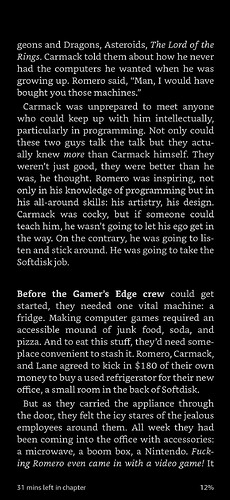I finished Masters of Doom last night. I just couldn’t put it down.
A few random thoughts.
Mentioning Descent as a Doom Clone bothered me a bit. It was the first fully 3D game like the kind Carmack was trying to build with Quake, not a Doom clone!
I was really tickled by the story of Tom Hall. He felt like an outcast at id software because he was the only one with a normal childhood and normal parents who were still together, and he actually went to university and graduated. It’s also interesting that the others felt like he was putting too much story in his games, and kept wanting to go back to Commander Keen. His levels and story for Doom made Romero and Carmack and the others finally fire him because his levels were too boring and realistic looking. Apparently a boring military base. So they went with Romero’s more abstract levels for Doom instead once Tom Hall was gone. And even after he was fired Tom felt it was because he wasn’t from a dysfunctional family like the others so he didn’t fit in. He comes into the story again as having been hired by Scott Miller at Apogee to do ROTT and work on Duke3D, and then he reunited with his friend Romero at Ion Storm where he did Anachronox. I wonder what he’s been up to since then? His emphasis on story and realism and instead of the more abstract aspects of Doom would probably have appealed to me even back then.
Another interesting character was American McGee. I know it’s sacrilege to admit this, but I didn’t really connect with Wolf3d and Doom, even though I finished the three episodes of Doom at the time. The game that truly made me a fan of first person shooters was Doom II. I really felt that the level design was so much better, as was the enemy design, and the super shotgun, of course. And out of the 36 levels of Doom II, apparently only 6 were from Romero. The rest were from Sandy Peterson and American McGee. So that was an interesting factoid to learn for me, who is a much bigger fan of Doom II than any of the other id software games. There’s a hilarious passage in the book about how during the development of Quake, Carmack became distant from Romero and instead went and hired Michael Abrash from Microsoft who became his programming buddy, and American McGee, who became his car mechanic/tinkering buddy. And Carmack was resentful of Romero spending his time overseeing Raven’s Doom clones instead of working on Quake. But the moment he was saying that to McGee, McGee wanted to be empathetic so he agreed, bad mouthing Romero, and Carmack immediately turned on him, thinking, who the hell does this kid think he is? And their relationship seemed to be more antagonistic from that moment on, at least in the book. American lasted through Quake 2, but got fired during the development of Quake 3.
It was also interesting reading about Diakatana again. At the time when that whole drama was happening, it seemed like such an eternally late game that would never ever come out. But reading about it now, it was under development for about 4 years. Under today’s standards, that doesn’t seem like that long a time, but back then it sure did. They started development in 1997, and showed off a demo in a Norwegian village at E3 in Atlanta that year, and that’s where Romero got his glimpse at the id booth of Quake 2 with its colored lighting, and he said we have to switch to the Quake 2 engine, which is what caused the first big problems with Diakatana. They couldn’t get access to the Quake 2 source code until Quake 2 actually came out, so they had to wait. And then when it did come out, Romero discovered just how much Carmack had changed the engine from Quake 1 to Quake 2, and that it was going to be a lot more difficult to switch than he expected.
At the end of the book in 2002, Carmack was working on Doom 3, with the rest of id software still miserable at having to go back to that well one more time, doing the same thing again because Carmack insisted. i have to admit, with id software ascendant again with Doom 2016 and Doom Eternal, I had kind of forgotten about the phase of post-Romero id software just repeating themselves over and over. Quake 2, then Quake 3, then Doom 3, and being internally miserable. Looking it up, it looks like Doom 3 finally came out in 2004, and it wasn’t Carmack’s last game, since he stayed on and worked on Rage after that. I guess Rage was the bridge between miserable id software and the more creatively happy id software that emerged with Doom 2016 without Carmack.
